From right-size discounts to AI-powered personalization, brands are getting as smart as consumers about BFCM
Over the past 3 years, both consumers and marketers have seen more disruption in their habits than probably in the past two decades.
From supply chain woes to the looming death of the third-party cookie, seemingly everything on which we once relied has shifted or changed—or it will soon.
In response, brands and consumers have gotten smarter—necessarily so:
They’re focusing more on customer lifetime value (CLV) and longevity than on return on ad spend alone—and they’ve searched for, and implemented, new AI tools and capabilities to scale faster and work more efficiently.
It’s no longer good enough to post ads on the latest social network, or to batch and blast messages unrelated to the information people give you. Consumers want to know how and why you targeted them, understand what data of theirs you have, and see that you’re using the data they’ve handed over to send them more relevant messages.
The outcomes of these behavior shifts had clear impacts during BFCM 2023, when brands using Klaviyo for email, SMS, and mobile push notifications sent over 11.6M messages per minute and generated nearly $60M of Klaviyo-attributed value per hour during peak times.
The most active marketing hour for Klaviyo businesses was 9 a.m. to 10 a.m. ET on Black Friday, during which 376M messages went out to subscribers and customers—a number that represents the power of email, SMS, and mobile push as complementary and essential marketing channels for the future.
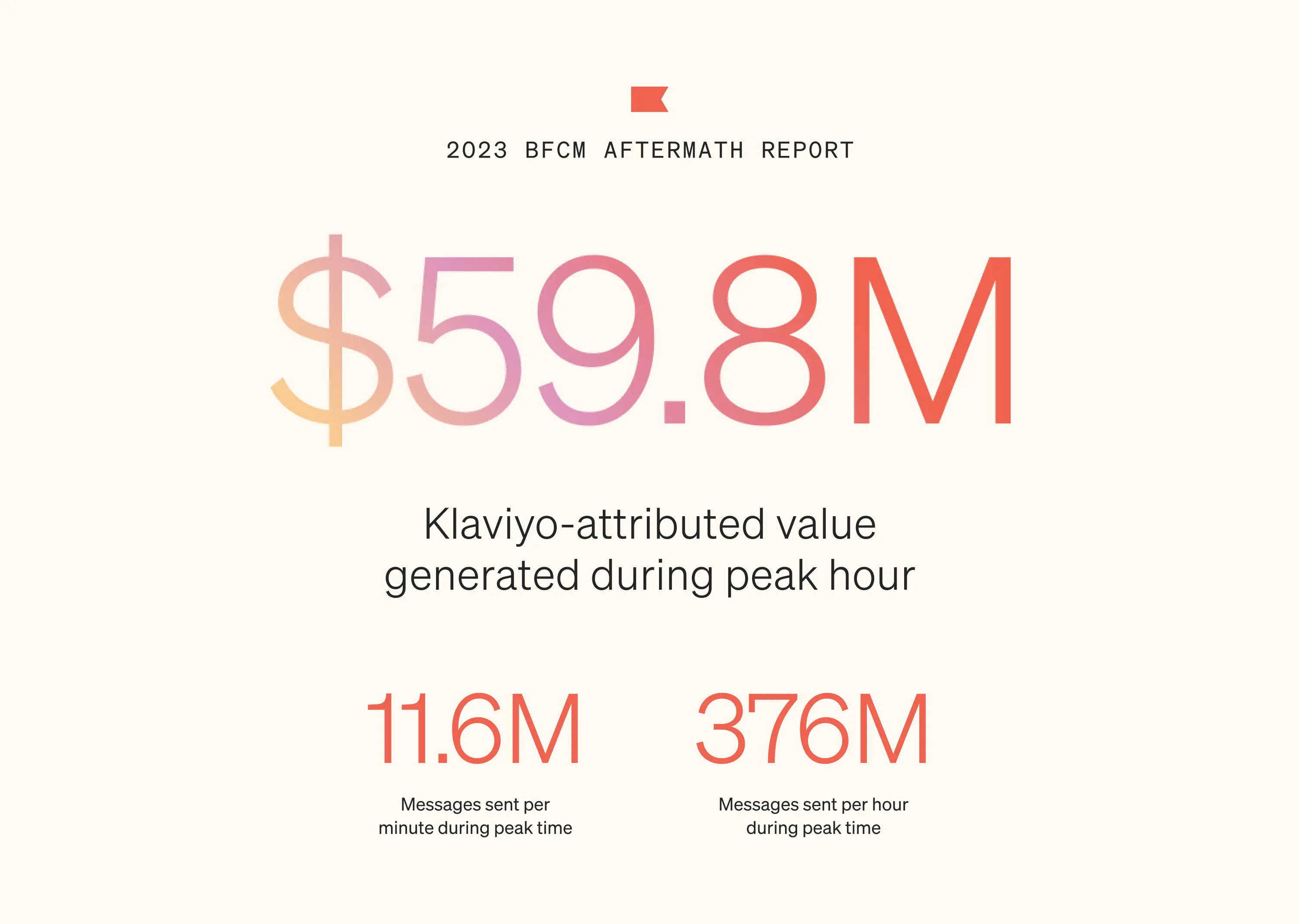
At a time when brands are relying less on paid advertising and more on building direct relationships with their customers, the numbers don’t lie: Owned marketing is growing alongside the brands that are investing in it.
Read on to learn exactly how.
Consumers are shopping with brands they love
BFCM is the one time of year in retail when most of your consumers are in market, credit card in hand. It’s critical that brands use this moment to bolster sales.
But competition is fierce, and consumers are savvy. They have plenty of choice regarding where to spend their money.
This year, our data shows that consumers spent heavily with brands they’d already made a purchase with—helping the retention and profitability efforts of retailers that invested in building a direct relationship with their customers.
And while discounts were important for converting consumers during BFCM, brands didn’t need to go all out. Based on our data, the 3 most common discount percentages were 30%, 20%, and 25%. And discounts in the 20-29% range converted best across all verticals—suggesting that consumers have brand preference, and discounts aren’t always enough to sway them elsewhere.
Repeat purchases make up nearly half of all BFCM sales
All brands must drive both acquisition and retention in order to hit profitability throughout the year. But while BFCM has long been considered an acquisition-first event, our data suggests otherwise: Nearly half (47%) of all purchases from Klaviyo customers during BFCM were made by repeat purchasers—pointing to the increased importance of customer retention and loyalty in BFCM success.
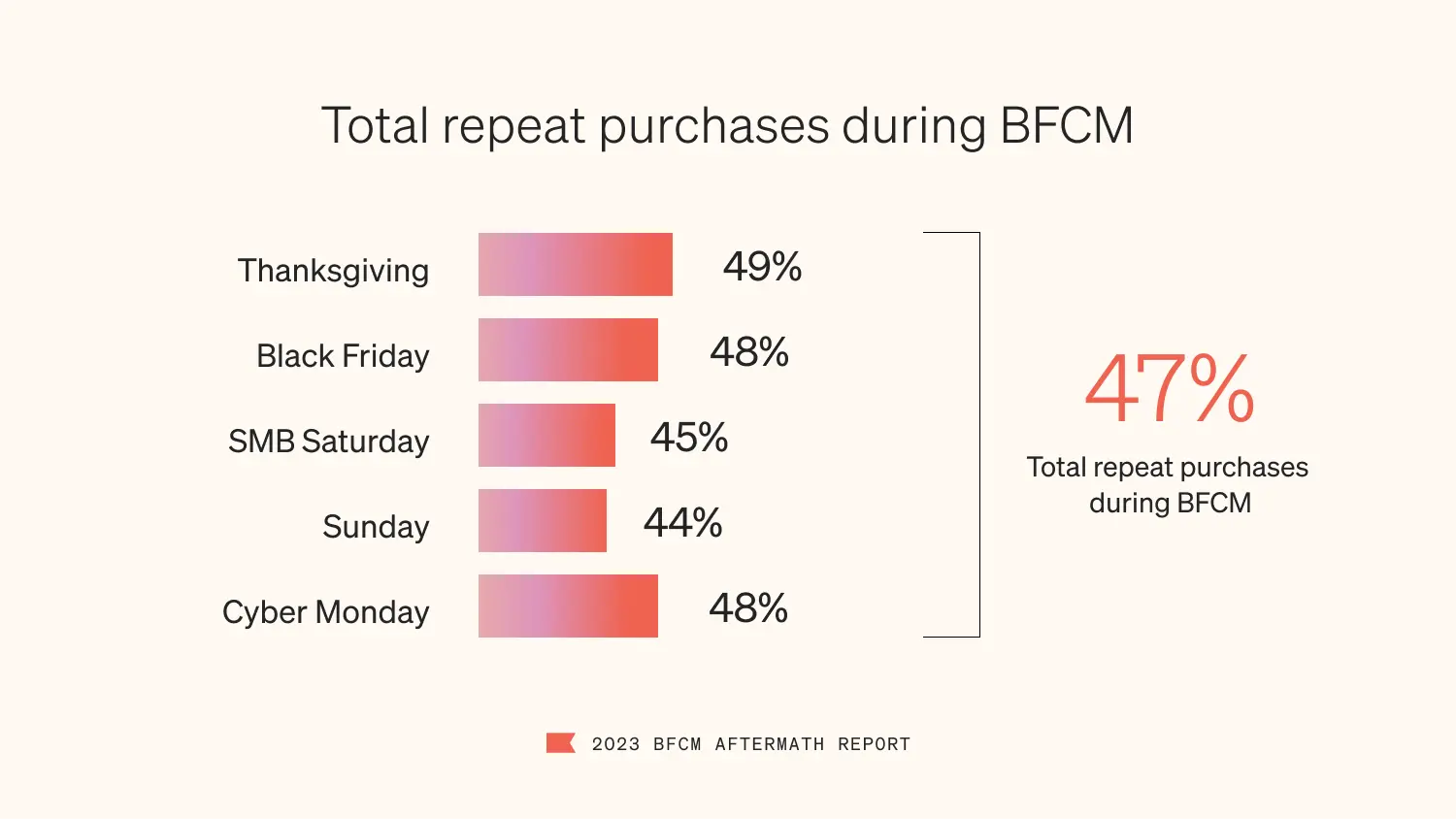
In your owned marketing channels across email, SMS, and mobile push, loyalty from existing customers takes up even more of your sales wins: 73% of all Klaviyo-driven purchases were made by repeat purchasers.
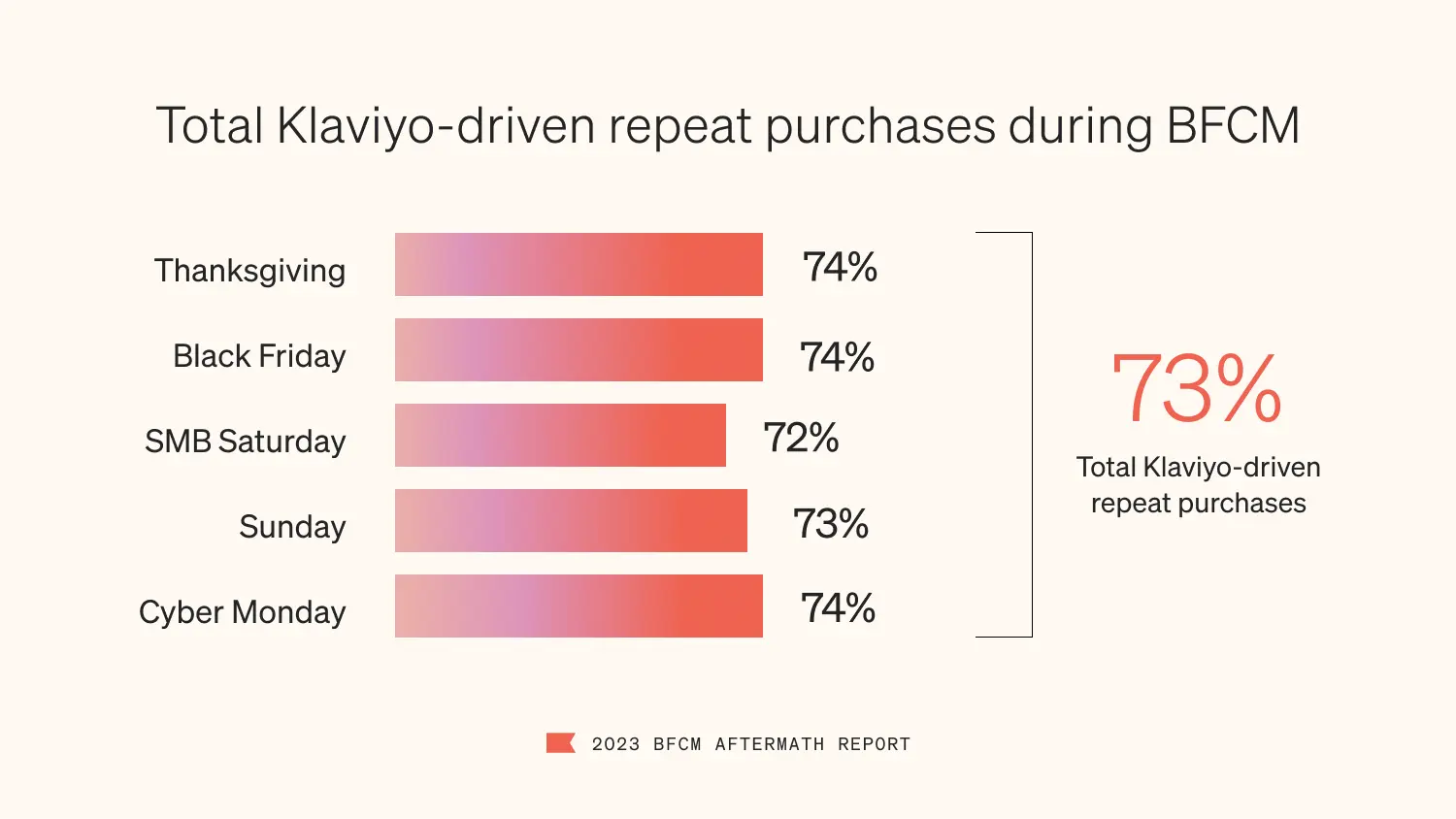
Maximize your acquisition efforts throughout the year, and BFCM can be a period of customer lifetime value (CLV) optimization—one in which you build better campaigns and programs for those who are willing and ready to not only buy again, but also share your products with friends and family.
Higher discounts do not necessarily equate to higher conversions
Discounts are a fraught tactic in a retail environment that’s squeezing margins. Consumers love them, and they take advantage of them. But brands are wary to use too many or discount too steeply, lest they lose sight of profitability.
Our BFCM data suggests brands don’t need to go further than the 20-29% discount bracket. It’s the bracket that converted the best in verticals like sporting goods, jewelry, home & garden, and hardware & home improvement.
There were exceptions to the rule, though. Outliers included food & beverage, where the best-performing discount was 80-89%; toys & hobbies, where the best-performing discount was 60-69%; and electronics, where the best-performing discount was 50-59%. These findings suggest competition is especially fierce in these verticals.
Brands in the apparel & accessories and health & beauty categories, meanwhile, may have built better loyalty among consumers: In these segments, the best-performing discounts were in the 1-9% bracket.
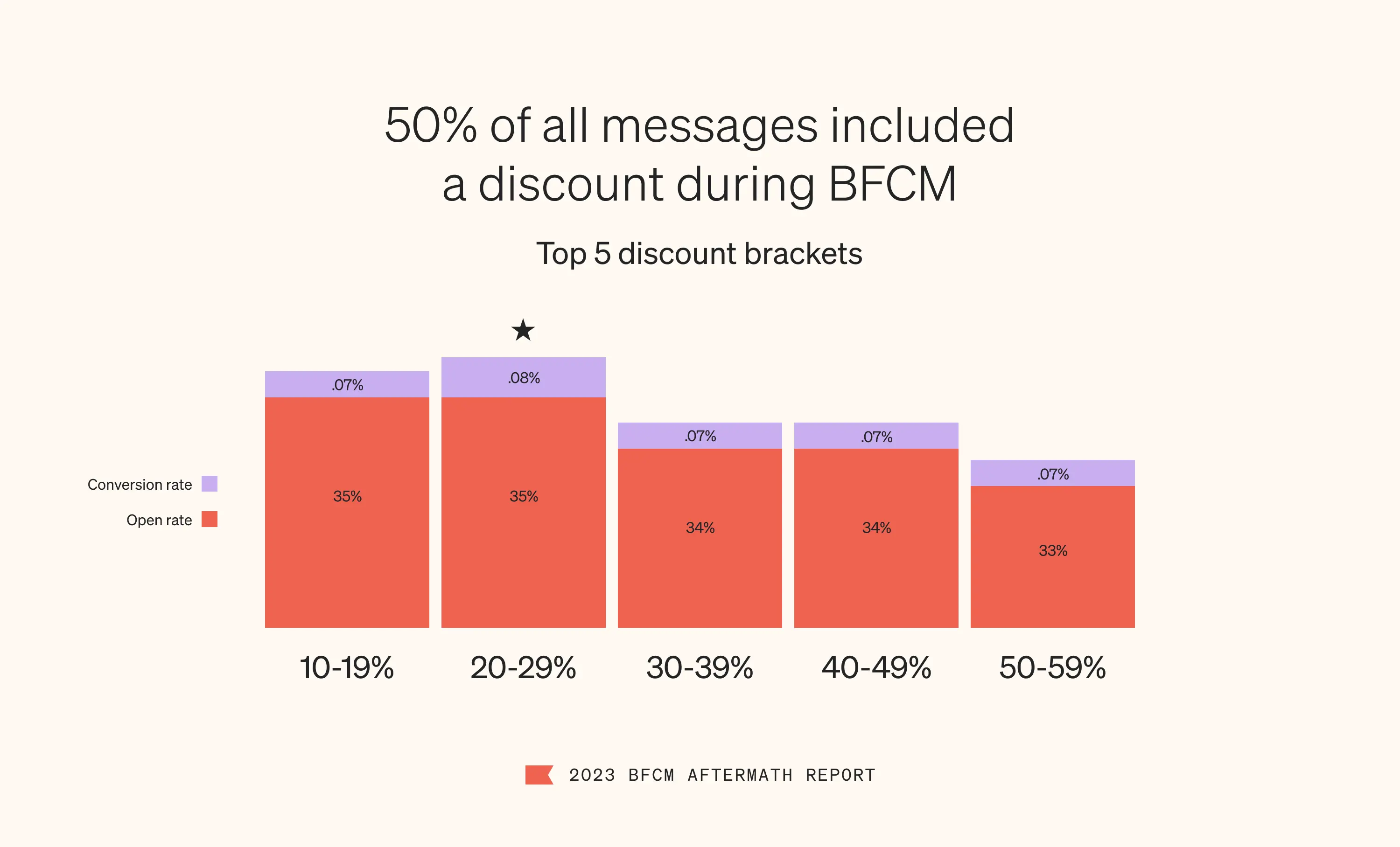
Brands are building meaningful, direct relationships—with the help of AI
Today’s consumers expect personalization, especially as brands collect more first- and zero-party data in preparation for the looming cookie-less era.
Klaviyo’s BFCM data proves it.
During BFCM, messages sent through our platform that were personalized with dynamic content earned 17% higher average click rates and 40% higher average order conversion rates than non-personalized messages.

Still, only 22% of marketing messages sent by Klaviyo customers during BFCM were personalized with dynamic content—suggesting there’s plenty of room for improvement.
That’s where AI can help.
AI-powered product recommendations take the labor out of personalization
Does your team have time to browse all your products, narrow them down, and make the best recommendations for each customer per email campaign during BFCM?
Absolutely not—but AI certainly does. While AI tools have been hotly debated in 2023 in terms of their usefulness, with concerns specifically around generative AI replacing human creativity, AI’s data processing capabilities save marketers time, increase efficiencies, and get personalized messages in front of consumers—a win-win for everyone.
During BFCM, 616M messages sent by Klaviyo customers included AI-personalized product recommendations.
To make that happen, Klaviyo’s AI sifted through historical and behavioral data to calculate 39.2B candidate products as recommendations before filtering them down to the most relevant ones.
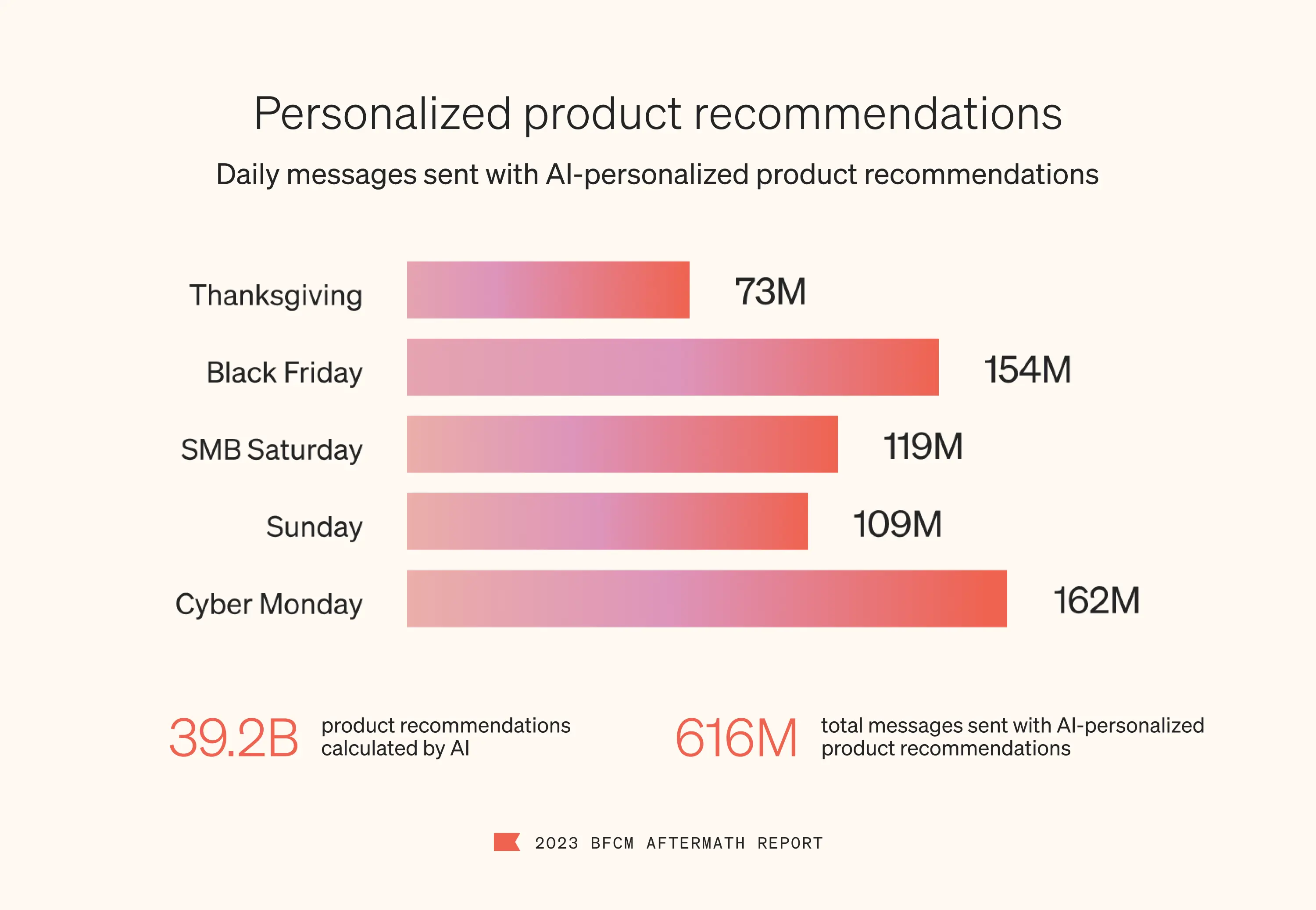
Outreach to predictive analytics segments reveals focus on long-term profitability
AI can do so much more than personalization, of course. Another one of its superpowers is prediction. And this BFCM, Klaviyo customers leaned heavily on segments built with AI-powered predictive analytics.
Sending to these segments is a clear indication from brands that quick, one-time holiday purchases are not the end game. Instead, the focus is increasing customer lifetime value (CLV) with each and every message—measured in not just conversion, but engagement with messages throughout a consumer’s journey as a brand builds a strong customer relationship.
In Klaviyo, segments created with predictive analytics include predicted next purchase date, predicted churn risk, predicted gender, and, of course, predicted CLV.
And while brands using Klaviyo sent 357M messages to these segments during BFCM, message volume actually began increasing a full week before Black Friday, on November 17. That’s when message volume to segments built with Klaviyo’s AI-powered predictive analytics jumped 33% over the average volume for the first two weeks of the month.
This wasn’t just about increasing CLV and loyalty during BFCM. Instead, brands began ramping up to offer incentives sooner for those customers predicted to be some of their most loyal.

We’ll never stop investing in our people
As dedicated as we are to ensuring our platform empowers efficiency and profitability on your terms, nothing can replace the power of a real person on the other end of the line to help solve issues in real time.
Klaviyo is deeply invested in making sure our customers succeed and get the help they need—not just on BFCM, but every single day of the year. After all, no marketer should go this road alone.
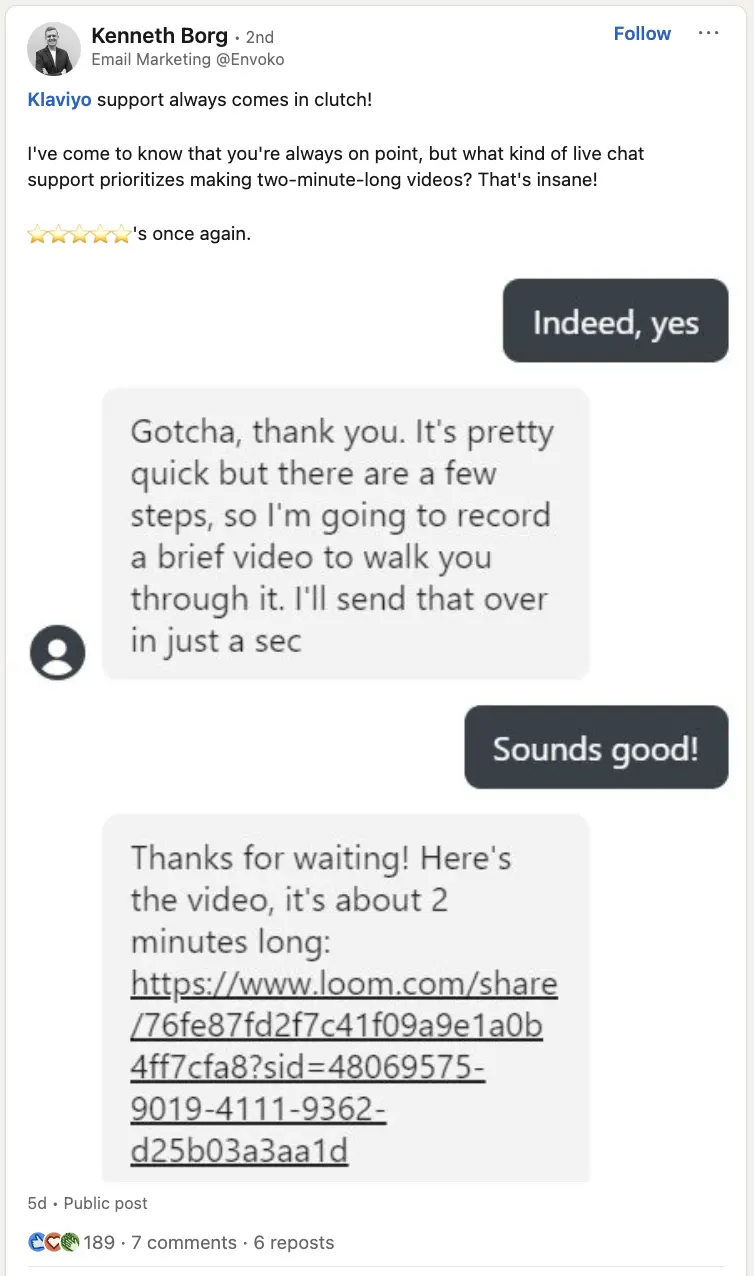
Like you, our doors don’t close during the busiest time of the year. This BFCM, the Klaviyo customer success team showed up to help our customers quickly—across multiple communication channels. Because when you’re stuck, speed and access are critical.

BFCM isn’t the finish line
Savvy brands know BFCM isn’t the finish line—it’s just one (important!) pit stop along the way to building smarter long-term digital relationships with customers.
But as your brand pivots into more efficient marketing strategies, you’re not just improving your bottom line. You’re also training your customers to expect more.
That’s a good thing—in such a competitive market, the fact that your customers are choosing to spend their money with your business is a serious compliment. A privilege, even.
It also means marketers must develop new tactics for jumping over a bar that’s always rising. And that requires always learning about how to better deliver the kind of personalized, meaningful experiences people know they deserve.
In other words, while BFCM is the most wonderful time of the year for most ecommerce brands, the work doesn’t end here.
Considering that recent Klaviyo research into consumer spending habits found that 25% of all consumers and 32% of Gen Z consumers are still holiday shopping post-BFCM, there’s still massive opportunity to:
- Analyze your marketing data from BFCM.
- Figure out what worked—and what didn’t.
- Pivot if necessary.
- Continue implementing winning email and SMS strategies to keep the momentum going strong, now through the end of the year (shipping deadlines run through December 23).
Remember: Klaviyo not only activates your data in real time so you can better personalize and measure all your customer interactions. It also connects you with customers through a seamless email, SMS, mobile push, and reviews experience, guides your marketing with built-in AI and predictive analytics, and helps you grow your audience, your CLV, and your total revenue.
With Klaviyo, marketers are equipped with the integrations and functionality they need to power smarter digital relationships—not just during BFCM, but all year long.
The full BFCM 2023 story, in a single image
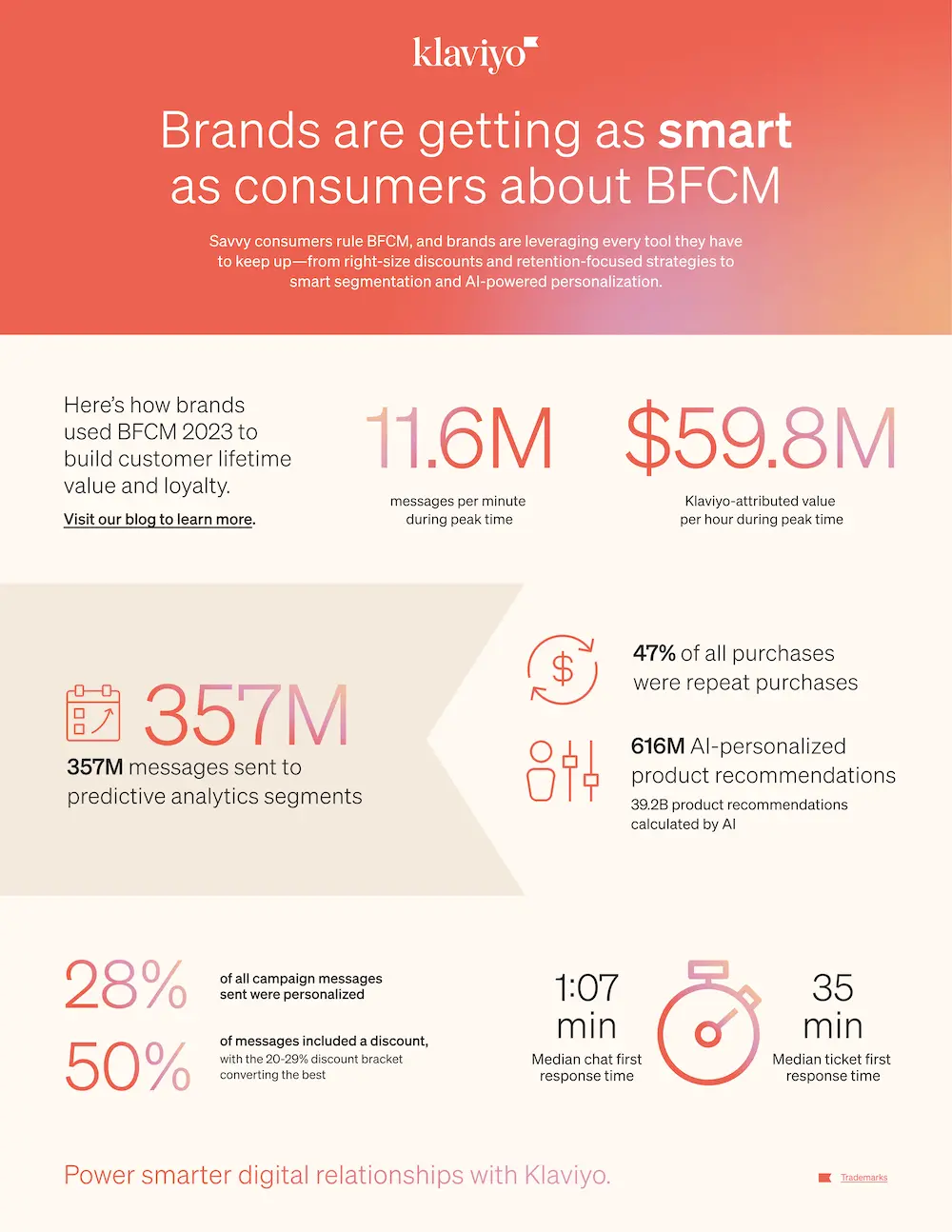

Related content

Learn about 11 Valentine’s Day marketing ideas that can boost Q1 revenue and gather customer data to take you into the rest of the year.

Learn 5 ways to turn new holiday shoppers into repeat buyers using personalization, seamless returns, targeted outreach, and AI-driven customer experiences.

Learn what to include in your photography style guide to create consistent, on-brand visuals across your B2C marketing channels.